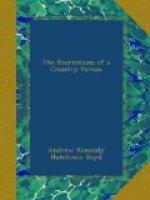Let us try to remember the names of the places which reach along the Frith upon either hand: we believe that a list of them will show that not without reason it is said that Glasgow is unrivalled in the number of her sea-side retreats. On the right hand, as we go down the Frith, there are Helensburgh, Row, Roseneath, Shandon, Gareloch-head, Cove, Kilcreggan, Lochgoil-head, Arrochar, Ardentinny, Strone, Kilmun, Kirn, Dunoon, Inellan, Toward, Port Bonnatyne, Rothesay, Askog, Colintrave, Tynabruach. Sometimes these places form for miles one long range of villas. Indeed, from Strone to Toward, ten or twelve miles, the coast is one continuous street. On the left hand of the Frith are Gourock, Ashton, Inverkip, Wemyss Bay, Skelmorlie, Largs, Fairlie: then comes a bleak range of sandy coast, along which stand Ardrossan, Troon, and Ayr. In the island of Cumbrae is Millport, conspicuously by the tall spire which marks the site of an Episcopal chapel and college of great architectural beauty, built within the last few years. And in Arran are the villages of Lamlash and Brodick. The two Cumbrae islands constitute a parish. A simple-minded clergyman, not long deceased, who held the cure for many years, was wont, Sunday by Sunday, to pray (in the church service) for ’the islands of the Great and Little Cumbrae, and also for the adjacent islands of Great Britain and Ireland.’
But all this while the steam has been fiercely chafing through the funnel as we have been stopping at Gourock quay. We are away at last, and are now crossing the Frith towards the Argyleshire side. A mile or two down, along the Ayrshire side, backed by the rich woods of Ardgowan, tall and spectral-white, stands the Cloch lighthouse. We never have looked at it without thinking how many a heart-broken emigrant must be remembering that severely simple white tower as almost the last thing he saw in Scotland when he was leaving it for ever. The Frith opens before us as we advance: we are running at the rate (quite usual among Clyde steamers) of sixteen or seventeen miles an hour. There, before us, is Cumbrae: over Bute and over Cumbrae look the majestic mountains of Arran; that great granite peak is Goat-fell. And on a clear day, far out, guarding the entrance to the Frith, rising sheer up from the deep sea, at ten miles’ distance from the nearest land, looms Ailsa, white with sea-birds, towering to the height of twelve or thirteen hundred feet. It is a rocky islet of about a mile in circumference, and must have been thrown up by volcanic agency; for the water around it is hundreds of feet in depth.




